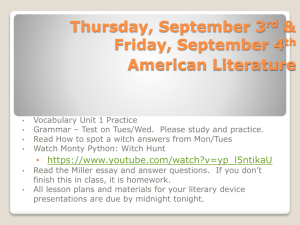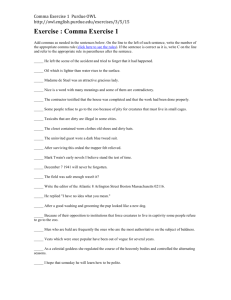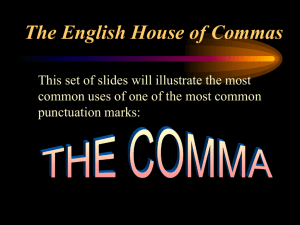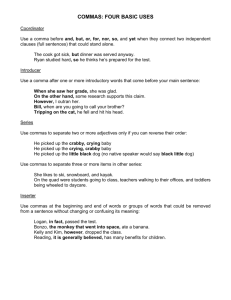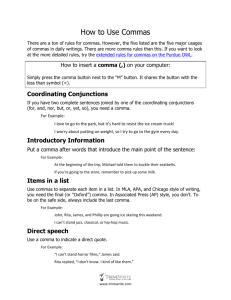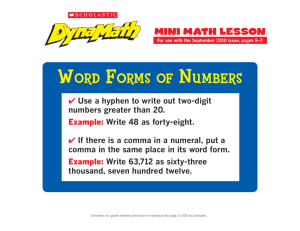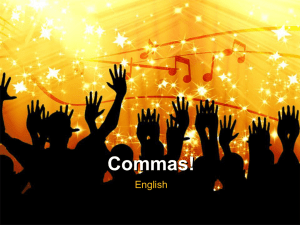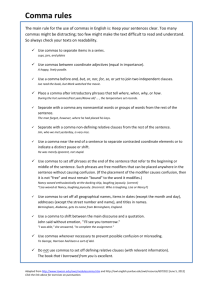Comma Rules PowerPoint
advertisement
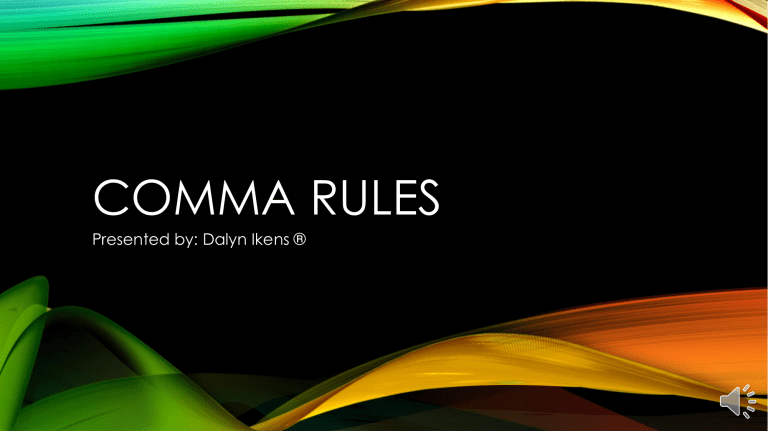
COMMA RULES Presented by: Dalyn Ikens ® RULE 1 Use commas to separate words and groups of words with a series of three of more. Example: My grandma always gives $100 dollars to me, my brother, my cousin Eric, and my cousin Ralph. * If you chose to omit the comma before AND you would indicate that Eric and Ralph have to share their $100. http://grammar.ccc.commnet.edu/grammar/commas.htm RULE 2 Use a comma to separate two adjectives(describers) when the word AND can be inserted between them. Example: Annabelle is a very smart, active little girl for her age. *My family did not go to the expensive Alaskan cruise this year due to my father being sick. You would not put a comma between expensive and Alaskan because you would not put AND between them. http://grammar.ccc.commnet.edu/grammar/commas.htm RULE 3 Use a comma when an –ly adjective is used with other adjectives Examples: Maxine was a sickly, old gal who still went jogging every Monday. **I had a hard time seeing Johnny through the opaquely stained glass. (NO comma needed because opaquely is not an adjective.) NOTE: To test whether an -ly word is an adjective, see if it can be used alone with the noun. If it can, use the comma. http://www.litscape.com/word_tools/ends_with.php http://grammar.ccc.commnet.edu/grammar/commas.htm RULE 4 Use commas before or surrounding the name or title of a person directly addressed. Examples: Would you, Teresa, marry me? No, Thomas, I will not! NOTE: Capitalization is needed when directly addressing someone with a title(Proper Noun). http://www.punctuationmadesimple.com/PMSComma.html RULE 5 Use a comma to separate the day of the month from the year and after the year. Example: My birthday party will be on March 22, 2014, at Yosemite National Park. Example: My birthday will be in March 2014 in Yosemite National Park. *If any part of the date is omitted, leave out the comma. http://www.punctuationmadesimple.com/PMSComma.html RULE 6 Use a comma to separate the city from the state and after the state in a writing assignment. If the abbreviated form of the state is used, you do not need a comma after the state. Examples: George Strait wrote a song about Cheyenne, Texas, where I grew up. George Strait wrote a song about Cheyenne, TX where I grew up. NOTE: With addresses on envelopes mailed via the post office, do not use any punctuation. George Strait wrote a song about Cheyenne, TX where I grew up. http://www.punctuationmadesimple.com/PMSComma.html RULE 7 Use commas to distinguish degrees or titles used with names. Commas are not used with Jr. and Sr. Commas never set off II, III, etc. Example: Peter Griffin, M.D., hired Doris Day Sr. and Elvis Presley III. http://www.punctuationmadesimple.com/PMSComma.html RULE 8 Use commas to set off expressions that interrupt sentence flow. Example: Cheri is, as you probably can see, very excited about her promotion. http://www.punctuationmadesimple.com/PMSComma.html RULE 9 When a sentence starts with a dependent clause, use a comma after it. However, do not use a comma when the sentence starts with a strong (independent) clause followed by a dependent clause. Examples: If you are not ready for this, let me know now. Let me know now if you are not ready for this. http://www.punctuationmadesimple.com/PMSComma.html RULE 10 Use a comma after phrases of more than four words that begin a sentence. This is the introductory phrase! Examples: In order to go to the store, we advise you make a list of essentials. NOTE: Introductory phrases usually consists of prepositional phrases. This may help in determining whether or not to use a comma. http://www.punctuationmadesimple.com/PMSComma.html RULE 11 APPOSITIVES & DESCRIBERS: If something or someone is sufficiently identified, the description following it is considered nonessential and should be surrounded by commas. Example: McKenzie, who makes straight A’s, always studies three hours before an exam. NOTE: McKenzie is named, so the description is not essential; therefore set off by commas. The girl who makes straight A’s always studies three hours before an exam. NOTE: We do not know which girl is being referred to without further description; therefore, no commas are used. http://www.punctuationmadesimple.com/PMSComma.html RULE 12 Use a comma to separate two independent clauses joined by a coordinating conjunction--and, or, but, for, nor, yet, so. Example: I have prepared a lovely dinner, and he will have to clean once supper is over. http://www.punctuationmadesimple.com/PMSComma.html RULE 13 TAKE A BREATHER! As we know there are many reasons for the use of commas. We haven’t even learned them all. Something to remember is the biggest problem is overusing commas. Pausing is not necessarily a reason to place a comma, this is where remembering your rules comes into play. https://www.google.com/search?q=funny+comma+jokes https://www.google.com/search?q=smiley+emojis RULE 14 A comma splice is an error caused by joining two indepedent clauses with only a comma instead of separating the clauses with a conjunction, a semicolon, or a period. A run-on sentence, which is incorrect, is created by joining two independent clauses without any punctuation. Incorrect: Time flies when we are having fun, we are always having fun. (Comma splice) Time flies when we are having fun we are always having fun. (Run-on sentence) Correct: Time flies when we are having fun; we are always having fun. OR Time flies when we are having fun and we are always having fun. OR Time flies when we are having fun. We are always having fun. http://www.punctuationmadesimple.com/PMSComma.html RULE 15 If the subject does not appear in front of the second verb, do not use a comma. (independent/conjunction/dependent) Example: She ran quickly but was unable to jump high enough. (She ran quickly/but/was unable to jump high enough.) http://www.punctuationmadesimple.com/PMSComma.html RULE 16 Use commas to introduce or interrupt direct quotations. Examples: Mom screamed, “I will paint your back-porch red!” “MOM!,” I exclaimed, “She did it!” http://www.punctuationmadesimple.com/PMSComma.html RULE 17 Use a comma to separate a statement from a question. Example: Molly likes apples, doesn’t she? http://www.punctuationmadesimple.com/PMSComma.html RULE 18 Use a comma to separate contrasting parts of a sentence. Example: This my dog, not the family’s. http://www.punctuationmadesimple.com/PMSComma.html RULE 19 Use a comma when beginning sentences with introductory words such as well, now, or yes. Examples: Yes, I will go to church on Sunday. Well, would you look at that sunset! https://owl.english.purdue.edu/owl/resource/607/02/ RULE 20 Use commas surrounding words such as therefore and however when they are used as interrupters. Examples: I should, therefore, demand a payment. I would be frightened, however, to go on the big roller-coasters. https://owl.english.purdue.edu/owl/resource/607/02/ RULE 21 Use either a comma or a semicolon before introductory words such as namely, that is, i.e., for example, e.g., or for instance when they are followed by a series of items. Use a comma after the introductory word. Examples: Today at the store we need items for BBQ; i.e., sauce, chicken, and beans. This is where you can also use a comma! NOTE: i.e. means that is; e.g. means for example https://owl.english.purdue.edu/owl/resource/607/02/ MISUSE How to use correct SYNTAX No spaces before, one space after No comma before an opening parenthesis. The aside takes the place of the comma in the sentence. https://owl.english.purdue.edu/owl/resource/607/02/ THE END! GOOD LUCK WITH ALL FURTHER USE OF COMMAS

